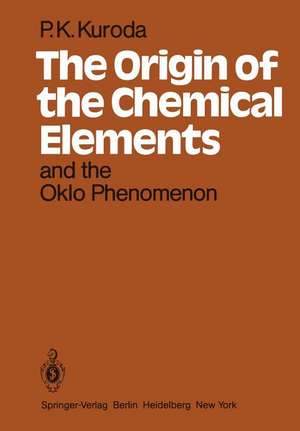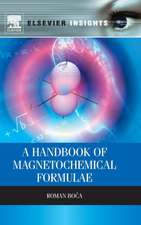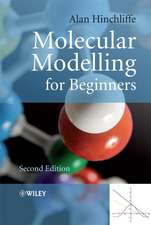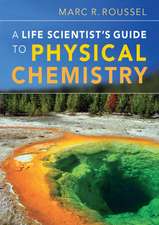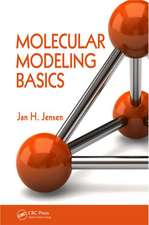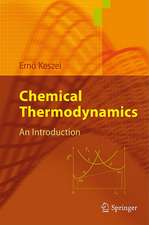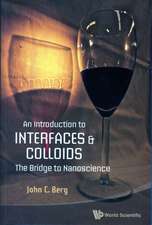The Origin of the Chemical Elements and the Oklo Phenomenon
Autor P. K. Kurodaen Limba Engleză Paperback – 6 dec 2011
Preț: 383.33 lei
Nou
Puncte Express: 575
Preț estimativ în valută:
73.37€ • 79.73$ • 61.67£
73.37€ • 79.73$ • 61.67£
Carte tipărită la comandă
Livrare economică 21 aprilie-05 mai
Preluare comenzi: 021 569.72.76
Specificații
ISBN-13: 9783642686696
ISBN-10: 3642686699
Pagini: 184
Ilustrații: XII, 166 p.
Dimensiuni: 170 x 244 x 10 mm
Greutate: 0.3 kg
Ediția:Softcover reprint of the original 1st ed. 1982
Editura: Springer Berlin, Heidelberg
Colecția Springer
Locul publicării:Berlin, Heidelberg, Germany
ISBN-10: 3642686699
Pagini: 184
Ilustrații: XII, 166 p.
Dimensiuni: 170 x 244 x 10 mm
Greutate: 0.3 kg
Ediția:Softcover reprint of the original 1st ed. 1982
Editura: Springer Berlin, Heidelberg
Colecția Springer
Locul publicării:Berlin, Heidelberg, Germany
Public țintă
ResearchCuprins
1. Introduction.- 2. Abundance of the Elements.- 2.1. Mendeléeff and the Periodic Law.- 2.2. The Ideas of Crookes.- 2.3. Richards and Atomic Weights.- 2.4. Clarke’s Numbers.- 2.5. The Rule of Harkins.- 2.6. The 1930 Estimates by Noddack.- 2.7. The 1938 Estimates by Goldschmidt.- 2.8. Geochemical Classification of the Elements.- 2.9. The 1956 Estimates by Suess and Urey.- 3. Elements 43 and 61 in Nature.- 3.1. The All-Present Theory of Noddack.- 3.2. Discoveries of Elements 43 and 61 by Artificial Means.- 3.3. Magic Numbers.- 3.4. Technetium in Stars.- 3.5. Long-Lived Isotopes of Technetium.- 3.6. Reported Discoveries of Technetium in Terrestrial Minerals.- 3.7. Absence of Primordial Technetium in the Earth’s Crust.- 3.8. Molybdenum-99 in Non-Irradiated Uranium Salts.- 3.9. Technetium in Pitchblende.- 3.10. Promethium-147 in Non-Irradiated Uranium Salts.- 3.11. Promethium in Pitchblende.- 4. The Oklo Phenomenon.- 4.1. Discovery of Spontaneous Fission.- 4.2. Plutonium-239 in Nature.- 4.3. Large-Scale Nuclear Processes on the Earth.- 4.4. Xenon Isotopes in Radioactive Minerals.- 4.5. Radioactive Strontium Isotopes in Pitchblende.- 4.6. Iodine-129 in Pitchblende.- 4.7. Radioactive Iodine Isotopes in Aqueous Uranium Solutions.- 4.8. Resonance Capture of Neutrons in Pitchblende.- 4.9. The Theory of Natural Reactors.- 4.10. The Uranium-238 to -235 Ratio in Nature.- 4.11. The Uranium-234 to -238 Ratio in Nature.- 4.12. Discovery of the Oklo Reactor.- 4.13. Promethium-147 in the Oklo Reactor.- 4.14. Plutonium-239 in the Oklo Reactor.- 4.15. Technetium-99 in the Oklo Reactor.- 4.16. Search for Additional Natural Reactors.- 5. Synthesis of the Elements in Stars.- 5.1. Discovery of Helium in the Sun.- 5.2. The Concept of Frozen Thermodynamic Equilibria.- 5.3. DeficientElements.- 5.4. The Rate of Thermonuclear Reactions.- 5.5. The C-N Cycle and the Proton-Proton Chain.- 5.6. Synthesis of the Elements in a Neutron-Rich Environment.- 5.7. The Big-Bang Theory of Gamow.- 5.8. The Polyneutron Hypothesis of Mayer and Teller.- 5.9. The Proton-Neutron Ratio Prior to the Big-Bang.- 5.10. Theories on the Evolution of Stars.- 5.11. Supernovae and Californium-254.- 5.12. Synthesis of the Elements in Stars.- 5.13. The e-Process According to B2FH.- 5.14. The s- and r-Processes According to B2 FH.- 5.15. Cosmic Black-Body Radiation.- 5.16. Pulsars or Neutron Stars.- 5.17. The World of Antimatter.- 5.18. Possible Climatic Effect of Supernova Explosion.- 5.19. Search for Neutrinos from the Sun.- 5.20. Temperature of the Sun.- 5.21. Further Studies on Nucleosynthesis in Stars.- 6. Plutonium-244 in the Early Solar System.- 6.1. Rutherford and Soddy’s View on the Transuranium Elements.- 6.2. Rutherford’s Calculation of the Age of the Elements.- 6.3. The Concept of Extinct Radioactivity.- 6.4. Half-life of Iodine-129 and the Age of the Elements.- 6.5. Excess 129Xe in Meteorites.- 6.6. The Plutonium-244 Hypothesis.- 6.7. Chronology of Nucleosynthesis.- 6.8. Plutonium-244 in the Early Solar System.- 6.9. Unsolved Problems in Xenology.- 6.10. Search for Superheavy Elements in Nature.- 6.11. Superheavy Elementary Particles and Quarks in Nature.- 7. Isotopic Anomalies in the Early Solar System.- 7.1. The Origin of Lithium, Beryllium and Boron.- 7.2. Isotopic Anomalies in Meteorites.- 7.3. A Unified Theory of Isotopic Anomalies.- 7.4. Neon.- 7.5. Argon.- 7.6. Krypton.- 7.7. Xenon.- 7.8. Barium.- 7.9. Gadolinium.- 7.10. Other Elements.- Appendices.- Appendix I. Goldschmidt’s table of the abundance of the elements (Originally compiled in 1938 and up-datedto 1954).- Appendix II. The 1956 Suess-Urey abundance table for the individual nuclei.- Appendix III. The 1965 abundance table compiled by Virginia Trimble.
